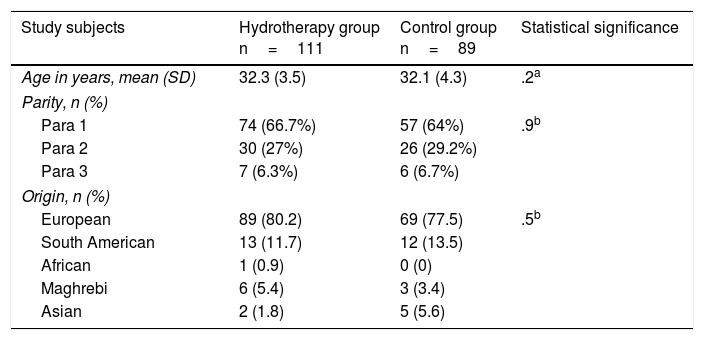To evaluate the effectiveness of the use of hydrotherapy in pain perception and requesting analgesia in women who use hydrotherapy during childbirth and to identify possible adverse effects in infants born in water.
MethodA multicentre prospective cohort study was performed between September 2014 and April 2016. A total of 200 pregnant women were selected and assigned to the hydrotherapy group (HG) or the control group (CG) according to desire and availability of use, data collection started at 5cm dilatation. The instruments used were the numerical rating scale (NRS), use of analgesia, Apgar Test, umbilical cord pH and NICU admission. Participants were distributed into: HG (n=111; 50 water birth) and CG (n=89).
ResultsPain at 30 and 90min was lower in the HG than in the CG (NRS 30min 6.7 [SD 1.6] vs 7.8 [SD 1.2] [p<.001] and NRS 90min 7.7 [SD 1.2] vs 8.9 [SD 1.1] [p<.001]). During the second stage of labour, pain was lower in pregnant women undergoing a water birth (NRS HG 8.2 [SD 1.2], n=50; NRS CG 9.5 [SD 0.5], n=89 [p<.001]). Relative to the use of analgesia, in the CG 30 (33.7%) pregnant women requested epidural analgesia vs 24 (21.1%) pregnant women in HG (p=.09). The neonatal parameters after water birth were not modified compared to those born out of water.
ConclusionThe use of hydrotherapy reduces pain during labour, and during second stage in women who undergo a water birth and the demand for analgesia decreases in multiparous pregnant women. No adverse effects were seen in infants born under water.
Evaluar la efectividad del uso de la hidroterapia en la percepción del dolor y solicitud de analgesia en las mujeres que la usen durante el parto e identificar posibles efectos adversos en aquellos neonatos nacidos dentro del agua.
MétodoSe ha diseñado un estudio multicéntrico de cohortes prospectivo llevado a cabo entre septiembre de 2014 y abril de 2016. Se incluyeron 200 gestantes, asignadas al grupo hidroterapia (GH) o grupo control (GC) según deseo y disponibilidad de uso, marcando el inicio de la recogida de datos a partir de los 5cm de dilatación. Los instrumentos utilizados han sido: la escala de valoración numérica (EVN), el uso de analgesia, el test de Apgar, el pH de cordón umbilical y el ingreso en UCIN. Los participantes se distribuyeron en: GH (n=111; 50 expulsivo en agua) y GC (n=89).
ResultadosLa media de dolor a los 30 y 90min de la aplicación de hidroterapia fue menor en el GH que en el GC (EVN 30min 6,7; [DE 1,6] vs. 7,8 [DE 1,2] [p<0,001] y EVN 90min 7,7 [DE 1,2] vs. 8,9 [DE 1,1] [p<0,001]). Durante el expulsivo el dolor fue menor en las gestantes de parto en el agua (EVN GH 8,2 [DE 1,2], n=50; EVN GC 9,5 [DE 0,5], n=89 [p<0,001]). Relativo a la analgesia, 30 gestantes del GC (33,7%) solicitaron analgesia epidural vs. 24 gestantes (21,1%) del GH (p=0,09). No se modificaron los parámetros neonatales tras el nacimiento en el agua.
ConclusiónEl uso de hidroterapia disminuye el dolor durante el trabajo de parto y durante el expulsivo en aquellas mujeres que realizan un parto en el agua, y la petición de analgesia disminuye en las gestantes multíparas. No se objetivaron efectos adversos en los neonatos nacidos bajo el agua.












